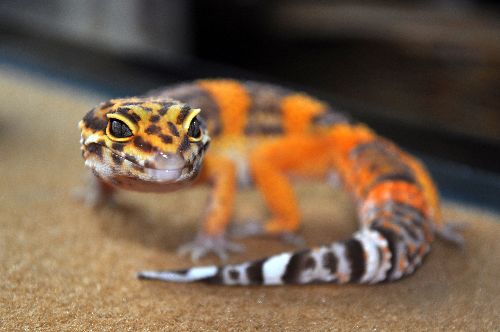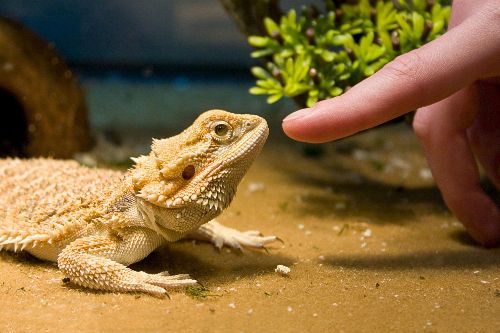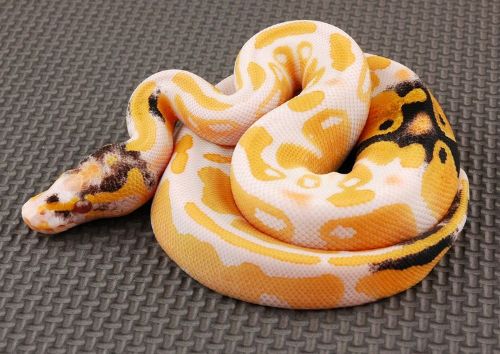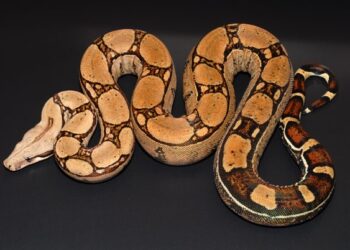Reptiles as pets are a captivating departure from traditional fur-bearing companions. Their unique charm and intriguing behaviors offer a delightful experience for those seeking something different. Cute reptiles can be just as lovable and interesting as cats or dogs, providing an exotic and endearing alternative.
Whether you are a seasoned herpetology enthusiast or a curious beginner, the world of reptiles holds a myriad of choices that are both adorable and manageable.
1. Leopard Gecko
The Leopard Gecko, adorned with vibrant spots reminiscent of a leopard’s coat, is a small yet striking creature known for its friendly disposition. These geckos are nocturnal and have a placid nature, making them an ideal choice for novice reptile owners.

Care Tips:
Leopard Geckos are remarkably easy to care for. They thrive in simple terrariums with heat sources to regulate their body temperature and hiding spots to mimic their natural habitat. Their diet primarily consists of live insects such as crickets and mealworms, supplemented with calcium to ensure proper health.
2. Crested Gecko
Crested Geckos, distinguished by their fringed crests running from their eyes to their tails, have a whimsical appearance and gentle demeanor. These nocturnal reptiles are known for their wide, expressive eyes and ability to cling to various surfaces.

Care Tips:
Crested Geckos flourish in vertically oriented terrariums that provide climbing opportunities. They require moderate humidity, which can be maintained through regular misting. Their diet includes commercial gecko food and occasional fruit purees, making them relatively easy to feed.
3. Bearded Dragon
The Bearded Dragon is a sociable and interactive reptile, often recognized for its “beard” of spiny scales that it puffs out when threatened. These dragons are known for their docile nature and engaging behaviors, such as arm-waving and head-bobbing.

Care Tips:
Bearded Dragons need a spacious tank with UVB lighting to mimic natural sunlight and support their health. Their diet is omnivorous, consisting of insects, leafy greens, and vegetables. Regular interaction and handling help them remain tame and sociable.
4. Blue-Tongue Skink
Blue-tongue skinks are docile reptiles named for their distinctive blue tongues. Their calm demeanor and unique appearance make them a fascinating pet choice. These skinks are ground-dwellers and have a robust, elongated body.

Care Tips:
Blue-Tongue Skinks require a large enclosure with ample space to move around. A varied diet of fruits, vegetables, and protein sources like insects and cooked meat keeps them healthy. Regular handling ensures they stay accustomed to human interaction.
5. Ball Python
The Ball Python, known for its calm temperament and beautiful patterns, is a favorite among snake enthusiasts. When stressed, it curls into a ball, hence its name. These pythons are relatively small and manageable compared to other constrictors.

Care Tips:
Ball Pythons need a secure, well-ventilated tank with controlled temperature and humidity levels. Their diet consists of pre-killed rodents, and feeding them once every week or two suffices. They are low-maintenance pets that thrive in a stable environment.
6. Russian Tortoise
Russian Tortoises are small, hardy reptiles that can live for decades, offering long-term companionship. They have a charming, determined demeanor and are well-suited for both indoor and outdoor environments.

Care Tips:
These tortoises require a spacious outdoor pen or a large indoor enclosure with access to UVB light. Their diet is rich in leafy greens, providing essential nutrients. Regular interaction and a varied diet help maintain their health and well-being.
7. Corn Snake
Corn Snakes are gentle and easy to handle, making them an excellent choice for beginners. They come in a variety of colors and patterns, each more beautiful than the last. These snakes are non-venomous and relatively easy to care for.

Care Tips:
Corn Snakes need a secure tank with hiding spots and a temperature gradient to mimic their natural habitat. Their diet consists of appropriately sized mice, fed every week. These snakes are known for their docile nature and ease of handling.
8. Veiled Chameleon
Veiled Chameleons are fascinating reptiles, known for their ability to change colors and their independently moving eyes. They are arboreal, spending most of their time in trees, and have a distinctive casque on their heads.

Care Tips:
These chameleons require a vertically oriented enclosure with plenty of climbing opportunities. High humidity and UVB lighting are essential for their health. Their diet consists of live insects, and they require careful monitoring to ensure their well-being.
9. African Fat-Tailed Gecko
Similar to Leopard Geckos but with a distinctive fat tail, African Fat-Tailed Geckos are charming and easy to care for. They have softer colors and a calm demeanor, making them delightful pets.

Care Tips:
These geckos thrive in simple setups with appropriate heat and humidity levels. A diet of insects, along with occasional calcium supplements, keeps them healthy. They are nocturnal and prefer a quiet, low-stress environment.
10. Red-Eared Slider
Red-Eared Sliders are aquatic turtles known for the bright red markings near their ears and their playful nature. They are active swimmers and enjoy basking in the sun.

Care Tips:
Red-Eared Sliders need a large aquarium with a basking area and UVB lighting. Their diet includes aquatic plants, insects, and protein sources. Regular water changes and a balanced diet are crucial for their health.
Conclusion
The diverse array of adorable and cute reptiles offers a wealth of options for prospective pet owners. Each species has its unique charm and care requirements, making it essential to research thoroughly before bringing one home. Reptiles can be wonderful companions, provided their needs are met with diligence and care.
Share your experiences with pet reptiles in the comments. Explore more about each species through our other posts or recommended resources.









